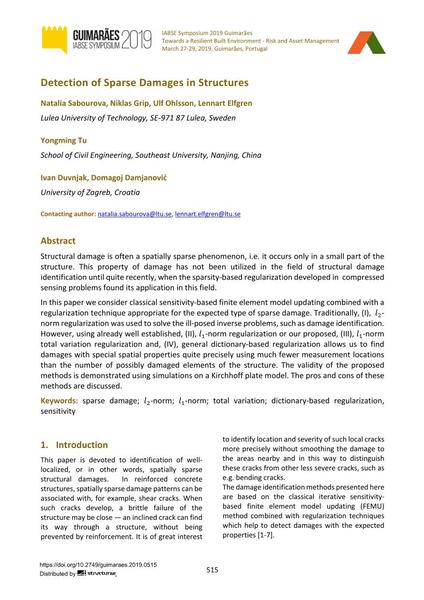Detection of Sparse Damages in Structures

|
|
|||||||||||
Bibliographic Details
| Author(s): |
Natalia Sabourova
(Lulea University of Technology, SE-971 87 Lulea, Sweden)
Niklas Grip (Lulea University of Technology, SE-971 87 Lulea, Sweden) Ulf Ohlsson (Lulea University of Technology, SE-971 87 Lulea, Sweden) Lennart Elfgren Yongming Tu (School of Civil Engineering, Southeast University, Nanjing, China) Ivan Duvnjak (University of Zagreb, Croatia) Domagoj Damjanović (University of Zagreb, Croatia) |
||||
|---|---|---|---|---|---|
| Medium: | conference paper | ||||
| Language(s): | English | ||||
| Conference: | IABSE Symposium: Towards a Resilient Built Environment Risk and Asset Management, Guimarães, Portugal, 27-29 March 2019 | ||||
| Published in: | IABSE Symposium Guimarães 2019 | ||||
|
|||||
| Page(s): | 515-522 | ||||
| Total no. of pages: | 8 | ||||
| DOI: | 10.2749/guimaraes.2019.0515 | ||||
| Abstract: |
Structural damage is often a spatially sparse phenomenon, i.e. it occurs only in a small part of the structure. This property of damage has not been utilized in the field of structural damage identification until quite recently, when the sparsity-based regularization developed in compressed sensing problems found its application in this field. In this paper we consider classical sensitivity-based finite element model updating combined with a regularization technique appropriate for the expected type of sparse damage. Traditionally, (I), 𝑙2- norm regularization was used to solve the ill-posed inverse problems, such as damage identification. However, using already well established, (II), 𝑙l-norm regularization or our proposed, (III), 𝑙l-norm total variation regularization and, (IV), general dictionary-based regularization allows us to find damages with special spatial properties quite precisely using much fewer measurement locations than the number of possibly damaged elements of the structure. The validity of the proposed methods is demonstrated using simulations on a Kirchhoff plate model. The pros and cons of these methods are discussed. |
||||
| Keywords: |
sensitivity sparse damage 2-norm l-norm total variation dictionary-based regularization
|
||||
